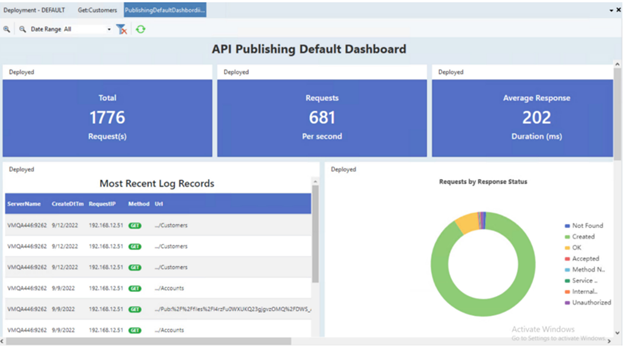
The 12 Best API Monitoring Tools to Consider In 2024
Application Programming Interface (API) monitoring tools are essential software solutions designed to closely monitor API performance, availability, and security. These tools track key performance metrics like response time, throughput, and latency, helping organizations identify and resolve any issues that could slow down or disrupt their services. These monitoring tools are essential for ensuring APIs remain available and reliable for users.
Consider an e-commerce platform that relies on APIs to process payments and manage inventory. An API monitoring tool would track the performance of these APIs, alerting the technical team if the payment API’s response time increases, which could indicate a problem. It would also monitor for unauthorized access attempts to the inventory API, providing real-time alerts to prevent potential security breaches. The primary goal of these features is to maintain high standards of performance, reliability, and security for APIs, ensuring they meet the needs of both the organization and its users.
Why Do Businesses Need API Monitoring Tools?
API monitoring tools are crucial for businesses to ensure their systems run smoothly. Without these tools, companies might face hidden issues such as slow response times, security vulnerabilities, and unexpected downtimes, which can disrupt operations and negatively impact user experience. By continuously tracking the performance and security of APIs, these tools help businesses maintain reliable and efficient services.
Here’s why API monitoring tools are essential:
-
Proactive Issue Detection and Resolution:
By identifying anomalies and potential problems before they escalate, these tools enable businesses to address issues swiftly, minimizing the impact on end-users. This approach is vital in maintaining a seamless user experience and upholding service level agreements (SLAs).
-
Enhanced Security:
APIs are often targeted by malicious actors seeking to exploit vulnerabilities. API monitoring software play a critical role in enhancing security by detecting unusual patterns of activity that may indicate a security breach. These tools provide timely alerts and detailed logs, which help businesses respond to security threats promptly and effectively.
-
Improved Developer Experience:
Ensuring a positive developer experience is crucial for organizations offering external developers APIs. API monitoring solutions help identify and resolve issues that could hinder developers’ productivity and satisfaction. By maintaining high API performance and reliability, businesses can foster a thriving developer ecosystem and encourage the adoption of their APIs.
What Do API Monitoring Tools Track?
API monitoring tools track various metrics to ensure APIs perform reliably and efficiently. Here are some key metrics they monitor:
- Uptime: Monitors the API’s availability to ensure it is operational without interruptions.
- Requests Per Minute: Measures the number of API requests handled each minute to understand its load and scalability.
- CPU Usage: This tracker tracks the amount of central processing unit (CPU) resources consumed by the API to identify performance bottlenecks.
- Latency: Measures the API’s time to respond to requests, impacting user experience.
- Memory Usage: Monitors the amount of memory the API uses to ensure efficient resource utilization.
- Time To First Hello World Measures the time it takes for a new API to respond to its first request, indicating how quickly it becomes operational.
- Errors Per Minute: Tracks the frequency of mistakes occurring in API requests to identify and address issues quickly.
The 12 Best API Monitoring Tools In 2024

1. Astera
Astera’s API Management platform is a comprehensive solution designed to streamline API creation, deployment, and management. With its no-code approach, users can create and implement APIs quickly and efficiently.
The platform offers extensive API monitoring capabilities, providing insights into the APIs’ performance, usage, and reliability.
Monitoring and Logging :
Monitoring and logging are key components of Astera’s API Management platform, which provides an inside look into API runtime information. The platform offers extensive monitoring information on your APIs, including API reports, dashboards, and logs.

Key features include:
- Granular API request logs with complete information about request meta information and runtime statistics.
- Aggregated API request logs displayed via visualizations, charts, and graphics on a customizable dashboard.
- Real-time monitoring of API traffic, requests by response status, and overall request and response time statistics.
- Live trace window for active API deployments, including various logs such as information, warnings, or errors.
- Detailed insights into server runtime and diagnostics for request validation, service availability, deployment activity, runtime component capacity, and health information
Astera’s platform supports the entire API lifecycle, from design and testing to deployment, ensuring optimal functionality across all your API operations. Other key features include:
Designing APIs:
Astera’s API builder provides a visual, intuitive interface for constructing request processing pipelines. Users can start with a request and end with one or multiple responses, applying various transformations, data access controls, and validation checks. The drag-and-drop interface supports integration with external APIs. It allows instant previews, auto-generated documentation, and one-click deployment for testing.
Testing APIs:
Astera emphasizes continuous testing and validation throughout the API development process. Users can preview APIs at every step to ensure proper functionality. Once fully developed, APIs can be instantly deployed for testing. APIs can be tested within Astera or via external tools or applications, with automatic documentation available for export.
Publishing APIs
Users can publish APIs as single endpoints for testing or in bulk for product deployment. Deployment through Astera is straightforward. Once deployed, APIs are ready for testing or production use, with automatically generated Open API documentation viewable in a browser or exportable to any API testing or consuming platform.
Ensuring Security:
Astera includes a built-in security framework that provides authorization and authentication features. It supports bearer token authentication and allows users to implement access control. The framework enables specific users or groups to manage only the resources relevant to their work domains.
Generating Documentation:
Astera supports the automatic generation of Open API documentation. This documentation can be a visual document—a web page—or an Open API (Swagger) collection. Open API is a standard that describes metadata for endpoints, which teams can use and share to call APIs from various testing tools or API consumption platforms such as Astera.
2. Datadog
Datadog is a monitoring platform designed for cloud-scale applications. It provides visibility into APIs, infrastructure, and applications’ performance and supports various integrations.
Key Features:
- Datadog allows users to test the availability and responsiveness of every endpoint in their API.
- The tool offers customizable dashboards and real-time visualizations that allow users to monitor KPIs and identify potential issues.
- Users can set up alerts for anomalies and performance issues based on predefined thresholds.
- Datadog’s anomaly detection capabilities empower users to investigate and troubleshoot problems efficiently.
- It supports integration with various technologies, including AWS, Azure, and Google Cloud.
3. AWS CloudWatch
Amazon CloudWatch is a monitoring and observability service provided by AWS. It collects and tracks metrics, monitors log files, and sets alarms.
Key Features:
- CloudWatch collects and tracks various metrics from AWS resources, including CPU utilization, disk space, and API request latency.
- Users receive configurable alerts that notify them of performance issues or anomalies when thresholds are breached.
- CloudWatch Logs allows you to ingest, store, and analyze log data from various applications and systems.
- Users can create custom dashboards with widgets to visualize API performance data.
- AWS CloudWatch integrates easily with other AWS services like Lambda, EC2, and RDS.
4. MuleSoft
MuleSoft’s Anypoint Platform offers tools for designing, deploying, and managing APIs and integrations across on-premises and cloud environments.
Key Features:
- Anypoint Monitoring allows users to search distributed logs and event data across the application network to identify the root cause of issues.
- Users can track trends and set custom alerts to detect problems, triggering notifications based on pre-defined thresholds.
- Built-in and custom dashboards provide visual metrics of the application network, helping users detect anomalies and troubleshoot issues.
- The platform includes authentication, authorization, rate limiting, and data encryption to protect APIs from attacks like SQL injection and XSS.
5. Postman
Postman is an API development and testing tool with monitoring capabilities. It allows developers to design, test, and monitor APIs efficiently.
Key Features:
- Postman supports many HTTP methods (GET, POST, PUT, etc.) and allows users to easily construct requests with different headers, parameters, and body content.
- It manages environment-specific variables like API keys, URLs, or database connections.
- Postman Monitors allows users to schedule automated tests for their APIs at regular intervals.
- Users can simulate API responses with Postman’s built-in mock server functionality.
6. RapidAPI
RapidAPI is a marketplace for APIs that also offers monitoring and analytics tools. It provides a platform for discovering, testing, and managing APIs.
Key Features:
- The platform provides access to a vast collection of APIs across various categories.
- Users can explore and test APIs directly within the platform and leverage comprehensive documentation for efficient development.
- RapidAPI offers insights into API usage, allowing users to track metrics like requests, latency, errors, and API traffic.
- Built-in security features within RapidAPI Studio help safeguard users’ APIs from unauthorized access and malicious attacks.
7. Apidog
Apidog is a platform focused on API development, testing, and monitoring. It supports the entire API lifecycle, from design to deployment.
Key Features:
- Apidog provides a user-friendly visual editor to design and document your APIs.
- The platform automates test generation and offers visual tools for writing assertions and extracting data.
- Apidog generates interactive API documentation directly from the definitions.
- It allows users to track API activity, identify performance bottlenecks, and monitor for errors.
- Apidog’s mock server automatically generates realistic mock data based on field names in the API definitions.
8. New Relic
New Relic is an observability platform that provides real-time insights into application and API performance. It supports monitoring across the entire tech stack, from infrastructure to end-user experience.
Key Features:
- New Relic collects a wide range of infrastructure metrics, allowing users to monitor resource utilization (CPU, memory, disk), network traffic, and overall system health.
- It provides tools for central log collection, analysis, and search from various sources within the infrastructure.
- New Relic is built to handle the monitoring demands of even the most complex and large-scale applications.
- The solution integrates with many tools such as Slack, Splunk, Sumo Logic, Chef, etc.
9. Runscope
Runscope, now part of BlazeMeter by Broadcom, is a tool designed specifically for API testing and monitoring. It provides testing and monitoring capabilities to help developers ensure the reliability and performance of their APIs.
Key Features:
- Runscope can monitor API uptime and performance from various locations worldwide.
- Users can use Runscope to verify that their APIs are returning the correct data.
- Runscope allows users to create basic checks to ensure their API is up and running, allowing them to handle simple and complex monitoring scenarios.
- It integrates with various notification tools such as PagerDuty, Slack, and email, alerting users immediately when API issues occur.
- Runscope monitors both public and private APIs, with cloud-based agents for global monitoring and an on-premises agent for private APIs.
10. Uptrends
Uptrends is a monitoring platform designed to ensure the performance and availability of websites, APIs, servers, and other online services. It offers API monitoring capabilities, allowing users to track the performance and reliability of their APIs.
Key Features:
- Uptrends allows users to set up multiple HTTP requests to test APIs comprehensively. Data from each request can be used in subsequent steps.
- The solution enables testing of redirects, authentication, CRUD operations, and other API interactions. It monitors result codes and checks for expected content.
- Uptrends provides real-time notifications for any detected API issues. Users can configure alert settings to ensure they are promptly informed of any problems.
- It supports authentication methods such as Basic, NTLM, Digest, and OAuth, including two-factor authentication (OAuth 2.0).
11. AlertSite
AlertSite offers real-time monitoring for APIs, websites, and applications. Its tracking and alerting capabilities ensure the reliability and performance of digital assets.
Key Features:
- AlertSite allows users to monitor complex user journeys involving multiple interactions with their application beyond basic API calls.
- It allows users to track the performance of their APIs from a global network of monitoring locations.
- AlertSite integrates with various popular tools and platforms, including project management tools, notification services, and analytics platforms.
- Users can create monitoring scripts visually with AlertSite’s user-friendly interface, in a no-code environment.
12. Moesif
Moesif is an API monitoring platform that provides deep insights into API usage and performance. It helps businesses understand how their APIs are being used and identify potential issues.
Key Features:
- Moesif monitors and tracks API usage, providing detailed insights through heat maps, time series, segmentation, funnels, and retention charts.
- The platform checks API properties against specific criteria, such as verifying the presence of a body field or ensuring HTTP header values remain within numeric limits.
- Moesif allows users to configure alerts to be notified whenever API errors occur, such as failed requests, timeouts, or incorrect responses.
- The platform allows analysis of user behavior based on different demographics or user groups for a more granular understanding.
API Monitoring Tools: How to Choose the Right
Selecting the right API monitoring tool ensures that APIs operate efficiently and align with business objectives. With numerous options available, it is important to identify the tool that best meets the specific needs of an organization. The following factors can guide organizations to choose the right API monitoring tool:
Comprehensive Monitoring Capabilities
Ensure the tool can monitor critical metrics such as uptime, response times, error rates, CPU usage, memory usage, requests per minute, latency, and more. Comprehensive monitoring offers a holistic view of the API’s health, facilitating prompt issue identification and resolution. Additionally, the tool should monitor individual API endpoints to pinpoint areas for improvement.
Real-Time Alerts and Notifications
Look for a tool that provides real-time alerts and notifications for anomalies or issues. This capability enables timely response and mitigation of potential problems before they escalate. Customizable alert thresholds and notification channels (e.g., email, SMS, Slack) ensure relevant personnel are notified promptly, enhancing incident response capabilities.
Ease of Integration
The tool should seamlessly integrate with existing systems and workflows, including CI/CD pipelines, logging systems, and other monitoring tools. Smooth integration facilitates implementation and enhances overall efficiency. Additionally, ensure compatibility with the APIs used, whether RESTful, SOAP, GraphQL, or others, to avoid compatibility issues.
User-Friendly Interface
A user-friendly interface simplifies tool setup, configuration, and effective usage. Intuitive design reduces the learning curve, allowing focus on monitoring and improving API performance rather than struggling with the tool. Features like customizable dashboards and easy-to-navigate menus enhance user experience.
Scalability
Choose a tool capable of scaling with business needs, ccommodating increased API traffic and complexity as operations expand. Scalability ensures continued effectiveness and efficiency, particularly for businesses experiencing rapid growth or seasonal traffic spikes.
Customization and Flexibility
The tool should offer customization options to tailor monitoring and alerts to specific requirements. Flexibility in setting up monitoring parameters, thresholds, and reporting formats enables adaptation to unique business needs, ensuring relevant and actionable insights.
Cost and Licensing
Consider the tool’s cost and licensing model to ensure it aligns with budgetary constraints while meeting monitoring requirements. Evaluate pricing based on factors such as API calls, users, or other criteria, ensuring scalability with business growth. Compare costs against features and benefits offered to maximize return on investment.
Final Thoughts
API monitoring is essential for maintaining the health and performance of modern software systems. By providing real-time insights and early detection of issues, API monitoring tools help ensure that APIs function smoothly and reliably. This proactive approach prevents downtime and performance bottlenecks and enhances the overall user experience. As businesses continue to rely on APIs for their digital operations, investing in the right API monitoring solutions becomes vital.
Monitor Your APIs Effectively with Astera
Astera’s API Management platform offers a complete solution for businesses seeking to optimize their API operations. Beyond its extensive monitoring and logging capabilities, Astera provides a comprehensive suite of features that support the entire API lifecycle. With detailed logs, real-time metrics, and customizable dashboards, Astera delivers deep insights into API performance and usage. It also offers a user-friendly interface for designing and deploying APIs, making it accessible for both technical and non-technical users.
Ensure your APIs are always performing at their best. Start your 14-day free trial of Astera’s API Management platform today and gain insights into your API operations.
 Astera AI Agent Builder - First Look Coming Soon!
Astera AI Agent Builder - First Look Coming Soon!


